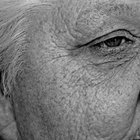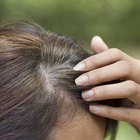
Jupiterimages/Pixland/Getty Images
Although hair color is dependant on dominant and recessive qualities, predicting hair color is more complex than predicting other genetic traits. Rather than one or the other, hair color is additive, meaning the pigment melanin along with a variety of genes determines how dark your hair will be.
Melanin
There are two kinds of melanin, eumelanin and phomelanin. A combination of these two is what determines the exact color of your hair.
Function
Hair color is determined by a number of genes. These genes determine the amount of eumelanin overall. The more eumelanin you have, the darker the hair color will be.
Dominant Hair Colors
Dark hair is dominant over blonde and light hair. Non-red hair colors such as blonde and brunette take precedence over red hair.
Recessive Hair Colors
Recessive hair colors include blonde hair, light hair, and red hair. This also means that although blonde hair is dominant over red hair, it is recessive to dark hair.
Other Factors
Because hair color is more dependant on the pigment melanin, it also subject to changes in the body. Infants have less melanin than adults, so they may have lighter hair color. Environmental factors like sunlight may also change it.
Related Articles

How Are Hair Colors Inherited?

Can Supplements Reverse Gray Hair?

Facts on Natural Hair Changing Color

Chlorella and Hair Loss

What Does Lemon Juice Do to Your Hair?

Matcha Green Tea Butter for Hair Growth

Can Age Spots Be Reversed?

How to Keep Burgundy Hair Vibrant

About Hair Bleaching

Ingredients in Hairfinity Vitamins

Difference Between Clover & Orange ...

How to Darken Bright Red Hair

Uneven Hair Growth

Types of Hair Treatment

How Long Should a Hair Toner Be Left on ...

What is Hair Composed of?

Zinc & Gray Hair

Difference Between Permanent Hair Color ...

Selenium & Zinc for Hair Loss

Aloe Vera & Seborrheic Dermatitis
Writer Bio
David Kennedy attended Purdue University in West Lafayette, Indiana. After graduating with a Bachelors of Arts in creative writing, he has continued his writing career through online freelance work with Demand Studios. Kennedy writes informational articles related to health, medicine, industry, computers and education.
Photo Credits
Jupiterimages/Pixland/Getty Images